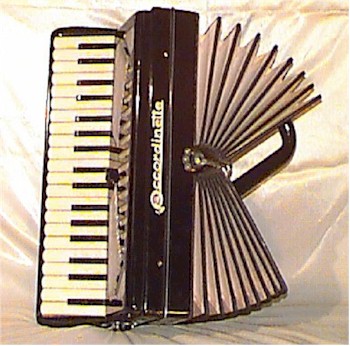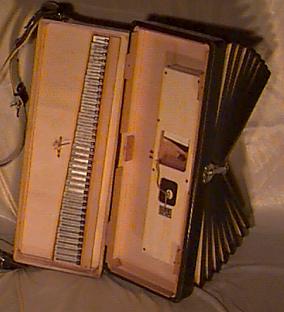A CROSCIO “FLUTTERBOX”
by Helmi Harrington, Ph.D.Curator--World Of Accordions Museum

One late-summer day in 1993, my husband and I were busy constructing new displays for A World of Accordions Museum (Duluth, Minnesota) [editor's note: the museum moved to Superior, Wisconsin, in 2002]. We were absorbed in the work and didn’t notice the entry of a young couple. The front door inadvertently had been left unlocked, although the Museum was temporarily closed due to construction. Despite the wood-strewn floor, machines, and general disarray—and my mild displeasure at the interruption—I gave a quick tour to the charming pair, accompanied by their very bright young daughter. Indicative of high intellectual niveau, they asked intelligent questions and seemed genuinely interested in historic instruments. The man, it turns out, is a professor of photography at the Univ. of Minnesota (Minneapolis), and his wife is a creative artist and aspiring accordionist. They were passing through Duluth en route from a vacation trip to Canada, where they had seen an unusual accordion for sale in a small music shop. From the description, I thought it might be a Bible Regal, which I would have been anxious to add to the collection. They were not able to recall the name of the shop, so I gave up hope of making contact or of acquiring the instrument. They must have seen my excitement, and disappointment. A week later, I received a phone call from Jeff Milliken, our museum visitor, who had retraced his steps in deliberate effort to find the instrument. He described what he saw before him, though his descriptive accuracy was hampered by lack of technical vocabulary. Nonetheless, it sounded intriguing, so I accepted the offer of the instrument in trade for lessons for Carrie Kalweit, his wife. In a few days, the appointed time came to see the “find”—they, fearful that the instrument would disappoint—I, unsure of the practicality of my trade.
In the nondescript suitcase I beheld a minor miracle, an accordion the likes of which I had seen only in picture from the catalog of the accordion museum in Castlefidardo. The instrument labeled on the front as “Accordinette,” had a piano keyboard of nearly three octaves, and one grill shift. The bellows opened and closed from a hinge-point at bellows-center, and only a large handle where the bass section should have been. The shift did not provide unison or octave sound, but rather, accessed or denied an unusual fluttering of the acoustic reeds. From that first moment its informal name became “Flutterbox.”
Behind the keyboard is found “Brevetto….Croscio; Made in Italy.” This ten-lb., 17” instrument appears consistent with manufacture in the 1950s. Inside the “Accordinette” are found single-tongue reeds, air being circulated by the bellows in only one direction over the tongues. The shift closes the internal air-supply-hole of a secondary pan with a weighted pallet-like flapper that starts and stops airflow to the reeds at the rate of about five movements per second. When engaged, the instrument sounds much like a harmonica. Unlike a normal “reservoir” instrument, however, the bellows allow dynamic variations.

It is much smaller in size than the example in Castlefidardo. In the official English-language guide to the Castlefidardo Museum, the instrument is described as follows:
"# 69,‘Cantabile,’ Year 1952, Filli Croscio (Stradella). The name of Croscio is very famous. Mario was very well known and appreciated in Paris, together with Piermaria and Cavagnolo, as a constructor of fine ‘musette’; and Ettore in Stradella where he maintained the excellent reputation of the homeland. The instrument on show in the Museum is a very curious one. It has ‘balancing’ bellows to regulate a more uniform air flow, no bass notes and ‘natural’ tremolo. Vitaliano Mancino (a very fine innovator in this field of Castlefidardo) told us shortly before his death, that he had applied a particular type of register for the natural tremolo on the ‘Croscio’.1"
The idea of an artificially induced tremolo was not new to me. The Museum already had an 1890s Chemnitz concertina with similar internal substructure, doubled for air passage in both directions to accommodate diatonic reeds. Later, other accordions, a “Tremolo” button diatonic, and an Italo American piano accordion came into the Museum collection, both built with secondary pans and weighted, fluttering air-access pallets. Also, I remembered having seen a “Quiver” piano accordion of 1950s construction. That one had a heavy rubber shutter that nearly closed inside the bellows when a shift was engaged. This produced an effect similar to a bellow-shake. These instruments all look quite average, their unusual effects being noticed only when played in the optional shift settings. In contrast, however, the Accordinette’s distinctive shape always draws awed gasps from audiences, and most visitors to the Museum remember it as a highlight. So, the Accordinette has become a favorite participant in Museum concerts and is a regular member of the travelling exhibits.
However—I’m still looking for a Bible Regal!